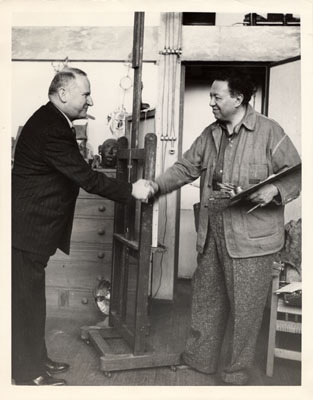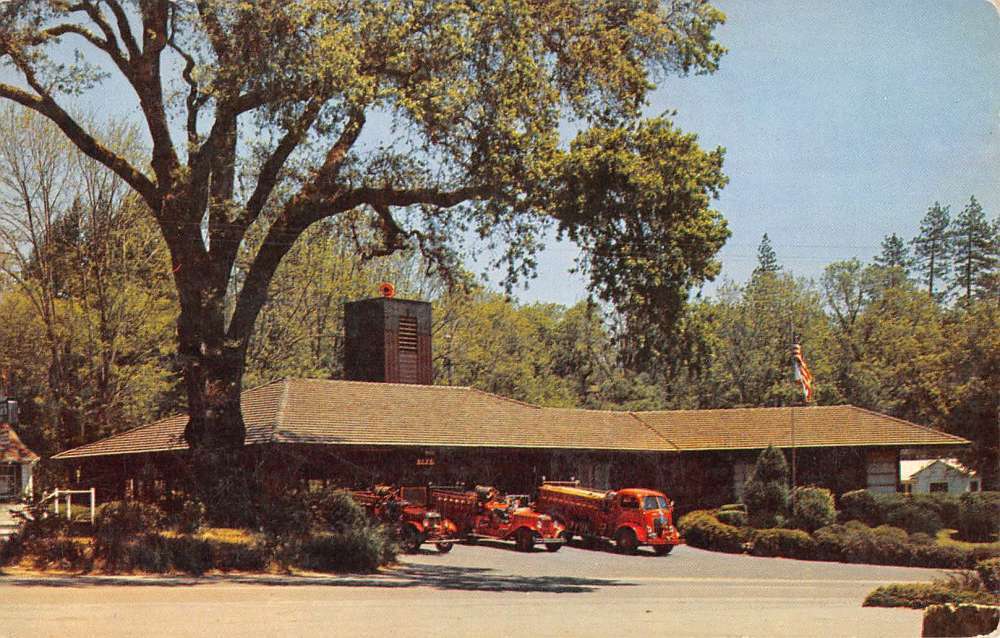Pflueger and Rivera and the Ben Lomond Fire Station
By Randall Brown
A remarkable event is taking place at the San Francisco Museum of Modern Art. Diego Rivera’s epic mural – “The Marriage of the Artistic Expression of the North and of the South on this Continent” – is being shown to the public for the first time in 80 years. The spectacular fresco – 74 by 22 feet – was produced during the 1940 Treasure Island Exposition. Rivera was the featured attraction at the “Art in Action” exhibit, creating the work in front of live audiences. The concept had been developed by his friend, Timothy Pflueger.
One of the Bay Area’s most respected and busy architects, Pflueger made his fortune during the prosperous 1920s. His specialties then were monumental corporate headquarters like San Francisco’s Pacific Bell building and ornate movie palaces like the Castro Theater. Adapting to the business downturn in the ‘30s, he took on a variety of less expensive projects – George Washington High School and the “Top of the Mark.” He played a role in the design of the Bay Bridge and the Treasure Island Exposition. And, in January of 1940, he accepted a commission from the Ben Lomond Volunteer Fire Department.
Knowing that the architect owned a vacation home in the area, Chief Earl Lyon took a trip to San Francisco. Pflueger agreed to draft plans for the project, quickly sketching out 9 possible designs. The preferred plan called for a two-wing structure, unified by a bell tower, reminiscent of the Rowardennan Hotel, recently destroyed by fire. Pflueger noted that the building would “be laid in harmony with the contours of the knoll where the structure is to go up.” Local redwood would be featured.
As the blueprints were being finalized, work began. An existing house was moved across Love Creek Road and a power shovel brought in to dig the foundation. Locals paid attention to costs, fearful of overruns. According to Lyon, “The architect said it couldn’t be built for $25,000. We got it up for $16,400.”

In April, while construction progressed, Pflueger headed to Mexico City to sell Rivera on his plan. After a week of negotiation, an agreement was reached. The artist would spend three months in action at Treasure Island, painting “in full view of the public.” The architect expressed pleasure. “Rivera has made very generous arrangements with us because he wants the fresco to be his contribution to the betterment of Pan-American relations. What we’re paying him will be just about enough to cover his expenses – no more. Yet he’ll be here the full length of the Fair.” The Exposition opened in May and the Examiner touted the Palace of Fine Arts as its “cultural heart.”
On a Sunday in June, nearly 1000 people gathered to dedicate Ben Lomond’s “New Model Firehouse.” A bottle of champagne was cracked against the building’s brass plaque. Speeches were followed by a barbecue prepared by local chefs Bacci Ratto and Frank Henfling. Pflueger attended the celebration and Lyon presented him with a fire helmet and a lifetime membership in the volunteers. The good will was mutual. “After it was all done,” Lyon recalled, “I kept after him for about a year to get our bill. Finally, he said there wasn’t going to be any bill.”

Rivera had not quite finished when the Exposition closed in the fall. When he was done, Pflueger arranged a one-day public showing. The fresco would then be stored pending the completion of its intended home – the library of a junior college to be designed by the architect. Among the guests was the artist’s then ex-wife, Freida Kahlo. Later in the week, the two visited City Hall to obtain a new marriage license. Pflueger offered Rivera a position as instructor at the California School of Fine Arts, but the couple chose to return home to Mexico City. Due to World War II, the library project did not leave the drawing board, and the artwork remained out of sight until this summer. sfmoma.org/exhibition/pan-american-unity
Randall Brown is an author and historian. He lives in Boulder Creek.
The San Lorenzo Valley Post is your essential guide to life in the Santa Cruz Mountains. We're dedicated to delivering the latest news, events, and stories that matter to our community. From local government to schools, from environmental issues to the arts, we're committed to providing comprehensive and unbiased coverage. We believe in the power of community journalism and strive to be a platform for diverse voices.





